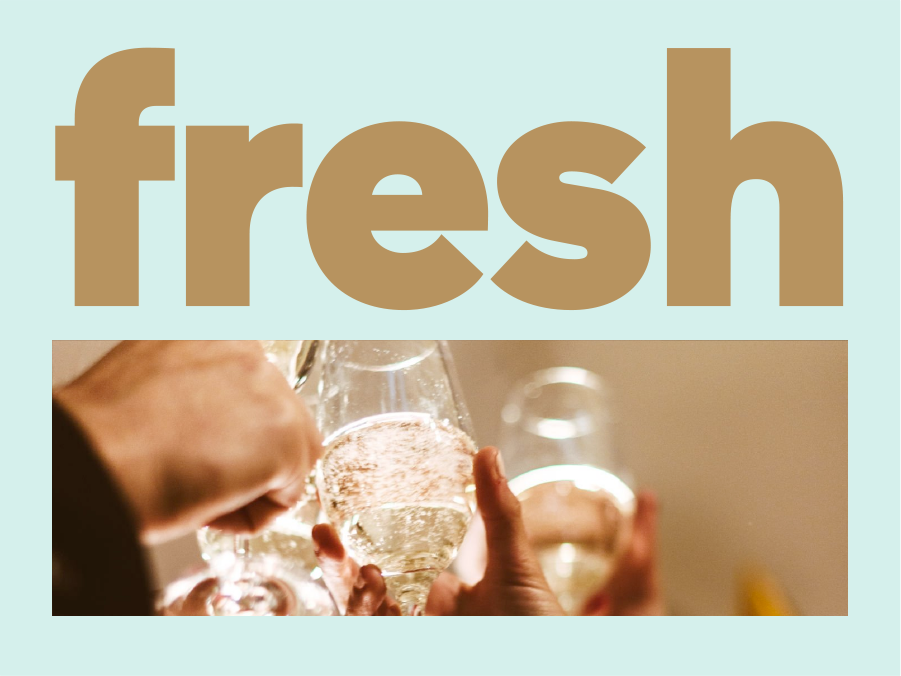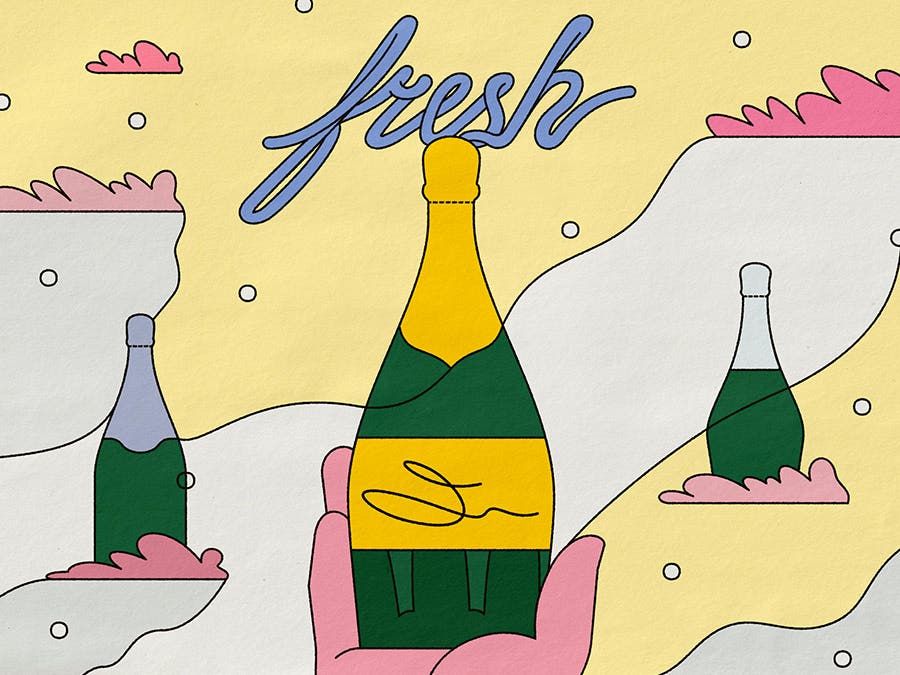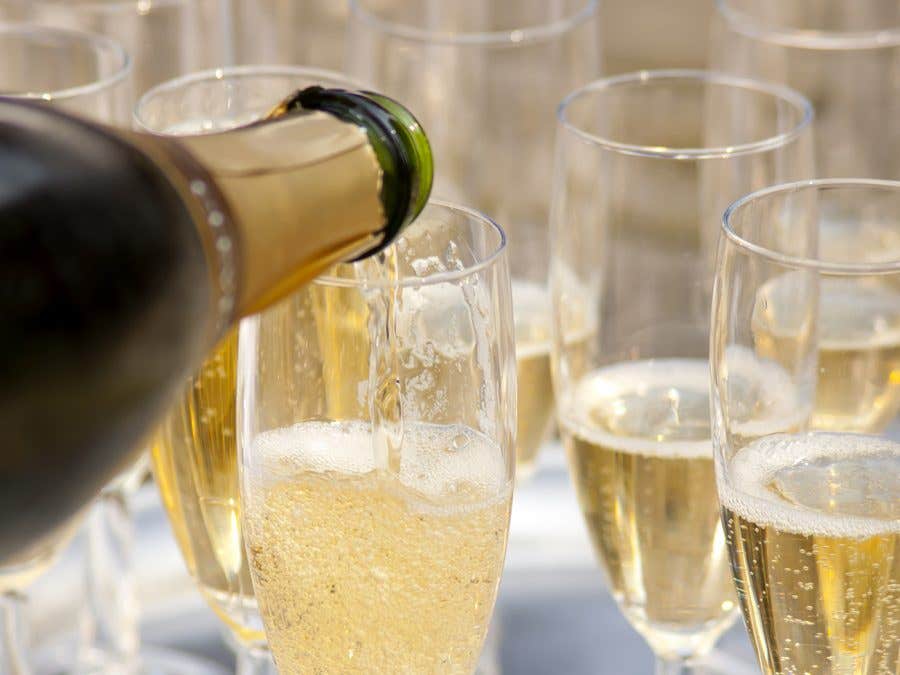A symbol of celebration and luxury, sparkling wine has long been associated with living the good life. For nearly two centuries, champagne was the drink of royalty and aristocracy. But with the arrival of Proseccos, pet nats and an array of other more affordable sparkling wines, bubbles have become immensely popular. While still considered a festive drink, sparkling wine can also be enjoyed in more casual settings, and it’s more accessible than ever, even finding a place at the dinner table alongside red, rosé and white wines.
Sommelier and historian Guénaël Revel, alias Monsieur Bulles, recently appeared on our Sous le bouchon podcast alongside Simon Bourbeau, Director, Spirits, Sparklers, Coolers and Beers, to chat about the latest trends in the sparkling wine world. It was a fun and insightful discussion with two fans of the fizz!
Why are bubbles so popular?
The fervour around bubbly isn’t new. When you think of F. Scott Fitzgerald’s classic The Great Gatsby or Dostoevsky’s The Brothers Karamazov, champagne has long been a symbol of wealth, easy living and social status. Starting in the 1920s, some 30 sparkling wines were available at the SAQ, then known as the Commission des liqueurs, including celebrated champagnes Veuve Clicquot, Moët & Chandon and Pommery.
But sparkling wine has only recently enjoyed wide-spread popularity. According to Monsieur Bulles, the 1990s marked a turning point.
Conquering the East
In 1989, the Berlin Wall fell and an entire population in Eastern Europe was suddenly exposed to western culture, discovering champagne and sparkling wines. “But with champagne’s limited production and sales, the west’s demands for bubbly weren’t being met. That’s when the Venetians stepped in!” explains Guénaël Revel.
Thanks to the Charmat/Martinotti method, which consists of fermenting the wine a second time in large, pressurized stainless-steel tanks, the Italians could produce affordable fizz on a large scale. Within a few decades, Prosecco production exploded, jumping from 100 to more than 660 million bottles a year.
Today, Italy is the planet’s largest producer of sparkling wines, surpassing France (550 million bottles), Germany (350 million), Spain (260 million) and the United States (162 million). (Data: Forbes, 2020.)
The Charmat method vs. the traditionnal method
There are several ways to make sparkling wine. The traditional method, or the Champenoise method, consists of starting a second fermentation in the bottle by adding sugar and yeast, which produces carbon dioxide gas. This technique is notably used in champagne, for crémants and for cava.
In the Charmat/Martinotti method, named for the two researchers who developed the technique in parallel in France and Italy in the early 20th century, the second fermentation takes place in large, pressurized tanks that retain the carbon dioxide produced. Long considered to be lower quality, this method has been refined over the years thanks to new technologies.
Pet nats, or naturally sparkling wines, use a rural or ancestral method that interrupts fermentation in the vat to complete it in the bottle.
A final method consists of injecting CO2 directly into a still wine to create carbonation, but this technique generally produces less elegant results.
Bubbles for all!
Champagne, cava, Prosecco, crémant, Lambrusco, Sekt, Clairette, Franciacorta—these days, bubbles are produced around the globe, for every palate and budget. “It’s perhaps the most diversified wine category,” says Guénaël Revel. “With prices ranging from $10 to $500, you have whites, rosés and reds. There’s something for every taste, and that’s what I love about sparkling wines.”
In Quebec, we’re fortunate to enjoy one of the world’s most varied selections of sparkling wines. “We have new bubbles coming in every week. We really strive to provide a lot of options in this category, covering all price points,” says Simon Bourbeau, who’s responsible for the champagne and sparkling wines portfolio at the SAQ.
According to Monsieur Bulles, two factors have contributed to this explosion in supply and demand: a surge in wine tourism and social media, which allows enthusiasts to discover a multitude of new products and for wine makers to boost their profiles in markets previously dominated by major wineries.
The trend for more natural wines also benefits these small producers. Even champagne is adjusting to meet this new demand. As Simon notes: “The champagne terroir is increasingly converting to organic and biodynamic production. We’re also seeing growing interest in artisanal champagnes, which are champagnes from a single producer, made with their own grapes.”
The fast-growing pet nats, or naturally sparkling wines, category is also attracting new converts, particularly among millennials. “It’s a simple wine with fine bubbles, to be enjoyed with friends, so it’s leading a lot of people into the bubbles category,” says Simon.
“Today, we’re making sparkling wines in Quebec that are increasingly noteworthy, that really are quite good.”
— Guénaël Revel
Quebec wines are spakling
A cool climate means acidity, which is essential to making bubbles. Developing local varieties, combined with global warming, has made it possible to create sparkling wines that compare favourably to wines produced elsewhere. When he travels abroad, Monsieur Bulles feels like an ambassador for Quebec bubbles: “I think we’re still in the experimental phase, but we can hold our own against certain cavas, certain crémants and other appellations in the world,” he believes.
Simon Bourbeau confirms that excitement for local fizz is bubbling: “Quebecers are thirsty for local sparkling wines. Sales of bubbly in Quebec have doubled in the last year. One taste and they’re hooked!”
Popping corks for every occasion
Alors, quel est le meilleur moment pour sortir les bulles? Pour nos deux experts, il y a un vin effervescent pour chaque occasion, grande ou petite.
“It may seem like overkill to show up to a get-together with a bottle of bubbly, but there’s a sparkling wine for every occasion, whether for brunch, cocktails, or simply hanging out in the park with friends,” says Simon. “Bubbles need to be laid-back; they’re not supposed to intimidate you!”
— Simon Bourbeau, Director, Spirits, Sparklers, Coolers and Beers
And bubbly is increasingly enjoyed at the table during meals. With so many sparkling wine options on the market, it’s easy to find the perfect pairing. “It’s the only wine in the world that goes with everything, any kind of food,” gushes Guénaël. Extra brut or sweet, white, rosé and even red, blanc de blancs, blanc de noirs—there’s a sparkling wine to accompany every dish. “The classics are of course fish and seafood. It’s easy to pair with savoury dishes,” he suggests.
Thanks to the popularity of spritzes and, more recently, negroni sbagliato, sparkling wine is also featured in many cocktail recipes. It’s a great way to add some pop to your concoctions at home!
“It will always have a celebratory quality. The familiar sound of a popping cork, it’s what bubbly’s all about,” says Monsieur Bulles.
Cheers!
A world of bubbly
France
The birthplace of bubbly, France has not only given us champagne, but several other appellations, including eight crémants (Jura, Alsace, Loire, Bordeaux, Bourgogne, Limoux, Die and Savoie), Vouvray and Blanquette de Limoux, considered the world’s oldest sparkling wine.
Italy
We’re all familiar with Prosecco, the world’s most popular sparkling wine that makes up most of Italy’s bubble production, but the country also has other appellations. These include Moscato d’Asti, which is sweeter, Lambrusco, a red sparkling wine, and Franciacorta, a sparkling wine from Lombardy made according to the traditional method that’s been gaining in popularity in recent years and is a particular favourite of Monsieur Bulles. Since 2021, the Prosecco DOC appellation has also permitted the production of rosé sparkling wines, a fast-growing category.
Germany
Germans love their bubbles! They consume 5 bottles per year per capita, which is neck and neck with France. That’s five times higher than Canada! Germany also happens to be the world’s third biggest producer of sparkling wines, ahead of Spain and the United States. Called Sekt, German sparkling wine is closely guarded—few bottles leave the German territory, so you’ll have to go there yourself to enjoy it. Cheaper Sekt is fermented a second time in pressurized vats, while higher quality wines like Deutscher Sekt, Sekt bA or Winzersekt are usually produced in the traditional method. Neighbouring Austria is also a large producer of Sekt.
Spain
Produced mainly in Catalonia’s Penedès region, cava is Spain’s iconic sparkling wine. Made according to the traditional method, with a second fermentation in the bottle, cava is produced in three categories, based on their minimum maturation: Cava de Guarda (9 months), Cava de Guarda Superior Reserva (18 months) and Cava de Guarda Superior Gran Reserva (30 months).
United States
The largest global importer of champagne and sparkling wines, our neighbour to the south is also the world’s fifth largest producer of bubbly. Several major champagne makers, including Moët & Chandon, Louis Roederer, Mumm and Tattinger, own vineyards in California, which explains some of its success.
England
With limestone subsoil and a climate similar to champagne’s, the United Kingdom is a new player worth watching in the world of sparkling wines. Growing the same varietals as its rival (Pinot Noir, Pinot Meunier and Chardonnay), England is striving to produce no less than the world’s best bubbly!
Brazil
Did you know Brazil makes bubby? That’s right. Chandon has run a winery there since the 1970s, in the Serra Gaúcha region, where some of the best Brazilian wine is produced. The variety of sparkling wines is surprisingly vast, from entry level bubbles to vintages that rival the best appellations.
Canada
With its cool climate, Canada is fertile ground for dry sparkling wines. Ontario’s Niagara Peninsula and Prince Edward County are particularly well-suited for growing Chardonnay, Riesling, Pinot Noir and Gamay, ideal varietals for bubbly. Excellent sparkling wines can also be found in British Columbia, Nova Scotia and, of course, here in Quebec!
We recommend
-
Read more
"Fresh" is a new series of articles that explores the latest trends in the world of wines and spirits. To kick things off, we're turning our attention to a growing trend: artisanal champagnes.
-
Read more
A celebratory flute-filler that’s easy to drink and accessible, Cava is an international favourite that also features exceptional potential.
 Access to SAQ Inspire personalized services and store inventories are unavailable at the moment.
Access to SAQ Inspire personalized services and store inventories are unavailable at the moment. Free in-store delivery with purchases of $75+ in an estimated 3 to 5 business days.
Free in-store delivery with purchases of $75+ in an estimated 3 to 5 business days. 












